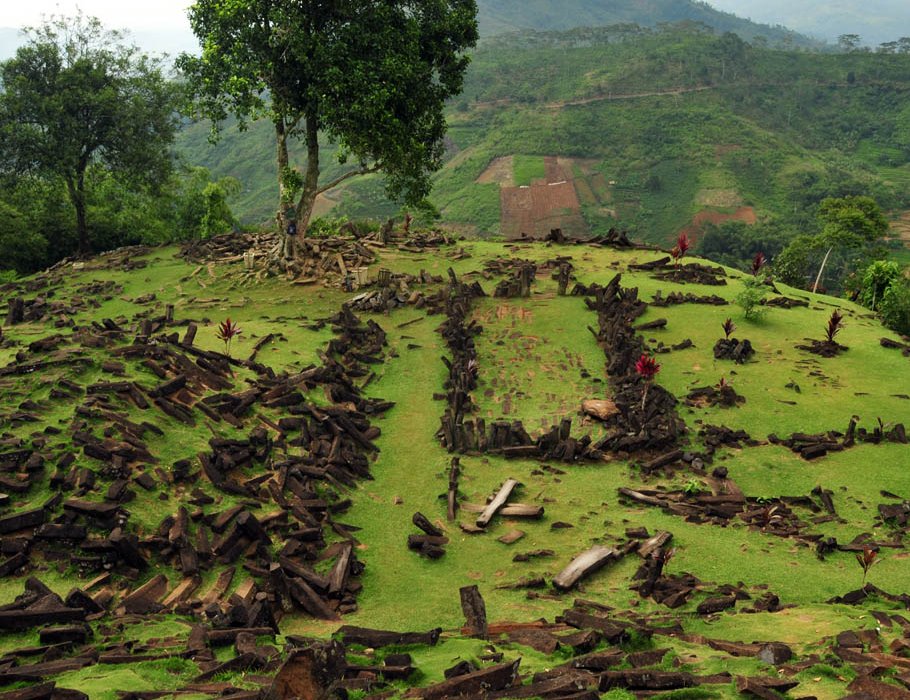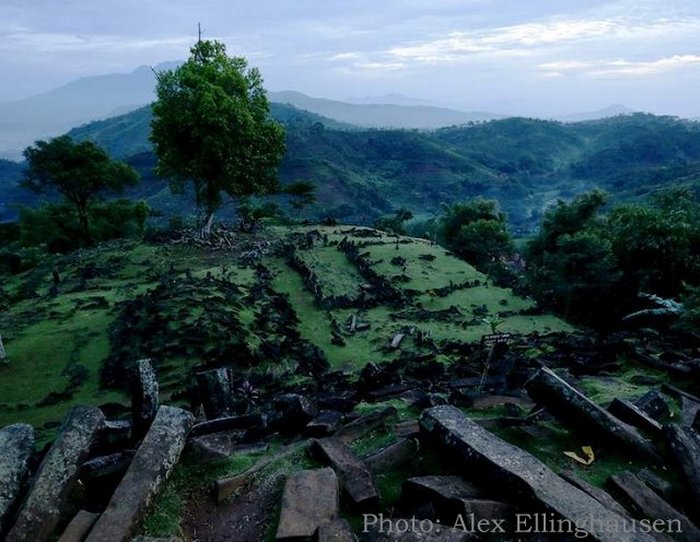Gunung Padang – Remarkable Megalithic Site In Indonesia
A. Sutherland - AncientPages.com - The megalithic complex on top of Gunung Padang has been known since the 1800s, but it was until 2011 that archaeologists published their studies regarding this one of the most fascinating sites in Indonesia.
Mount Padang Cianjur Megalithic Site.Image credit: Ilham.nurwansah - source
This remarkable megalithic site known as Gunung Padang is located 885 meters above sea level and 120 kilometers south of Jakarta, in Cianjur regency, West Java Province of Indonesia.
It occupies a hill covered with a series of terraces bordered by retaining stone walls of stone that are accessed by about 400 successive andesite steps rising approximately 95 meters.
The Sundanese people believed that Gunung Padang resulted from King Siliwangi's attempt to build a palace in one night. The asymmetric Punden Berundak faces northwest to Mount Gede and was constructed for the purpose of worship. The site was completed by 5000 BC, but some experts suggest it is much older.
According to ancient beliefs stretching back to antiquity, Gunung Padang is a sacred place. Gunung Padang (literally: Mount Padang, or Mount "Meadow/Field,"), means in the local Sundanese language "Mountain of Light" or "Mountain of Enlightenment."
Since Dutch colonists discovered it in 1914, Gunung Padang has been known as the largest among ancient megalithic sites in Indonesia.
Similar columns were used to build the Nan Madol on the island of Pohnpei in Micronesia.
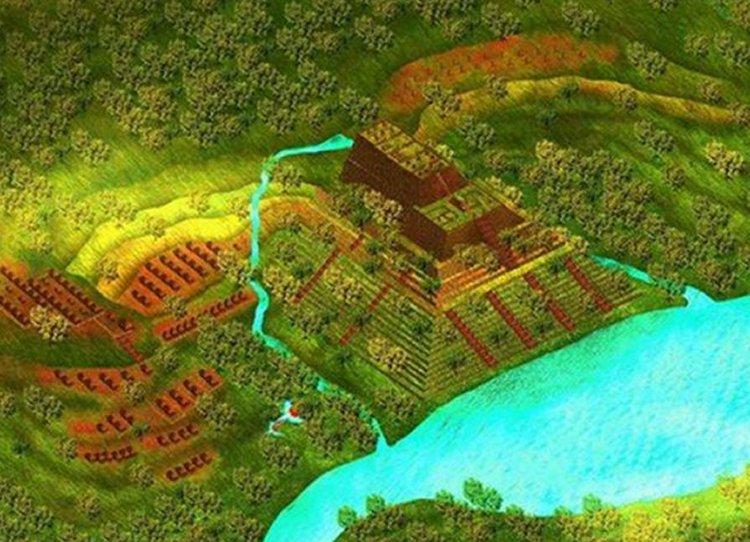 Artist’s impression of Gunung Padang as it would have looked in antiquity. Credits:© Pon S Purajatnika
Artist’s impression of Gunung Padang as it would have looked in antiquity. Credits:© Pon S Purajatnika
Where was the source of rock columns used to build the complex? The columns - perfectly suited for building different structures, even the gigantic ones - represent a unique geological formation, occurring in only a few places in the world.
Analysis of several core samples of the hill and structure have revealed greater and greater age the deeper the researchers looked. From 5000 years to 8000 years, to 10,000 years and all the way up to a reported 23,000 years old and even earlier!
These unbelievable results of the survey make Gunung Padang the oldest known structure of any kind on Earth, in fact. It is believed that the Gunung Padang structure is not a natural hill but a man-made pyramid and the origin of its construction goes back long before the end of the last Ice Age.
The sophisticated construction of Gunung Padang is massive even at the deepest levels, and its builders had extraordinary construction skills and certainly were not primitive men.
Excavations conducted in 2014 were temporarily halted when archaeologists discovered a large number of man-made artifacts and a massive structure below the surface.
The survey of the site indicates it was built in four different eras by those who were skilled engineers and possessed knowledge of astronomy and the surrounding area.
If the dating of Gunung Padang is correct, then this megalithic site was constructed when sea levels were as much as 130 meters (430 feet) lower than the present, and the current Java Sea was not a sea but fertile land.
In the landscape of this mysterious megalithic site is also included a 300-foot high pyramid whose base materials date back to 22,000 to 20,000 BC.
A sophisticated culture flourished in the region, and it was many millennia ago. Who were these people? What happened to them? Did they manage to escape before the land sank beneath the devastating waves?
Written by – A. Sutherland - AncientPages.com Senior Staff Writer
Updated on September 12, 2021
Copyright © AncientPages.com All rights reserved. This material may not be published, broadcast, rewritten or redistributed in whole or part without the express written permission of AncientPages.com
More From Ancient Pages
-
 Unique 3,300-Year-Old Hittite Bracelet With Symbols Discovered By Farmer
Archaeology | Mar 28, 2022
Unique 3,300-Year-Old Hittite Bracelet With Symbols Discovered By Farmer
Archaeology | Mar 28, 2022 -
 Idol Of Pachacamac Inca God Reveals Its Colors
Archaeology | Jan 21, 2020
Idol Of Pachacamac Inca God Reveals Its Colors
Archaeology | Jan 21, 2020 -
 Kylfings – Unknown Warriors Mentioned On Norse Runes – Were They Members Of The Varangian Guard?
Civilizations | Mar 15, 2018
Kylfings – Unknown Warriors Mentioned On Norse Runes – Were They Members Of The Varangian Guard?
Civilizations | Mar 15, 2018 -
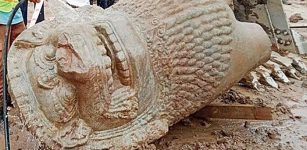 Two Pieces Of A Six-Foot-Tall Lion Statue Accidentally Found In Phnom Penh, Cambodia
Archaeology | Sep 12, 2020
Two Pieces Of A Six-Foot-Tall Lion Statue Accidentally Found In Phnom Penh, Cambodia
Archaeology | Sep 12, 2020 -
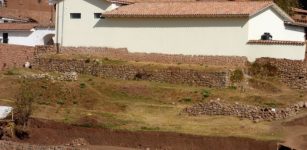 Impressive Inca Agricultural Terraces Discovered In Cusco, Peru
Archaeology | Jan 25, 2018
Impressive Inca Agricultural Terraces Discovered In Cusco, Peru
Archaeology | Jan 25, 2018 -
 How Was The 3,600-Year-Old Nebra Sky Disc Made? New Clues
Artifacts | Nov 29, 2024
How Was The 3,600-Year-Old Nebra Sky Disc Made? New Clues
Artifacts | Nov 29, 2024 -
 Ancient Egyptian Knowledge Of The Cosmic Engine And Unseen God Of The Universe
Featured Stories | Jan 15, 2019
Ancient Egyptian Knowledge Of The Cosmic Engine And Unseen God Of The Universe
Featured Stories | Jan 15, 2019 -
 Dispute And Mystery: Strange Case Of The Tomb KV55 In The Valley Of Kings, Egypt
Civilizations | Oct 8, 2015
Dispute And Mystery: Strange Case Of The Tomb KV55 In The Valley Of Kings, Egypt
Civilizations | Oct 8, 2015 -
 Unexplained Mystery Of Secret Knowledge And Extraordinary Sightings Hidden In An Author’s Book
Featured Stories | Nov 25, 2021
Unexplained Mystery Of Secret Knowledge And Extraordinary Sightings Hidden In An Author’s Book
Featured Stories | Nov 25, 2021 -
 Lemko People – European Minority That Lost Their Homeland And Still Live In Exile
Civilizations | Jan 13, 2020
Lemko People – European Minority That Lost Their Homeland And Still Live In Exile
Civilizations | Jan 13, 2020 -
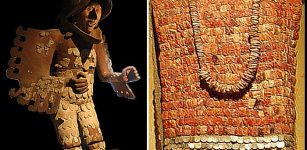 Fearsome Aztec Eagle And Jaguar Warriors Of Mesoamerica
Featured Stories | Sep 14, 2023
Fearsome Aztec Eagle And Jaguar Warriors Of Mesoamerica
Featured Stories | Sep 14, 2023 -
 Rare 3,000-Year-Old Weavings Discovered In Alaska
Archaeology | Sep 4, 2023
Rare 3,000-Year-Old Weavings Discovered In Alaska
Archaeology | Sep 4, 2023 -
 World Map Of Neanderthal And Denisovan DNA In Modern Humans
DNA | Apr 13, 2023
World Map Of Neanderthal And Denisovan DNA In Modern Humans
DNA | Apr 13, 2023 -
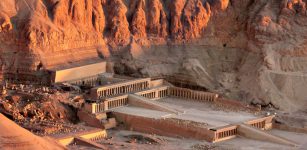 Deir el-Bahri – Sacred Resting Place For The Pharaohs
Featured Stories | Mar 22, 2022
Deir el-Bahri – Sacred Resting Place For The Pharaohs
Featured Stories | Mar 22, 2022 -
 142,000-Year-Old Shell Beads Found In A Cave Are The Oldest Known Evidence Of Human Communication
Archaeology | Oct 16, 2021
142,000-Year-Old Shell Beads Found In A Cave Are The Oldest Known Evidence Of Human Communication
Archaeology | Oct 16, 2021 -
 On This Day In History: Terracotta Army Buried With Emperor Qin Shi Huang Discovered – On Mar 29, 1974
News | Mar 29, 2017
On This Day In History: Terracotta Army Buried With Emperor Qin Shi Huang Discovered – On Mar 29, 1974
News | Mar 29, 2017 -
 Tragic Tale Of The Cursed House Of Atreus
Featured Stories | Apr 12, 2021
Tragic Tale Of The Cursed House Of Atreus
Featured Stories | Apr 12, 2021 -
 Mystery Of Mexico’s Bizarre Mummy May Never Be Solved
Featured Stories | Sep 17, 2024
Mystery Of Mexico’s Bizarre Mummy May Never Be Solved
Featured Stories | Sep 17, 2024 -
 Fionn Mac Cumhail: Legendary Irish Hero, Clairvoyant And Leader Of Fianna Warriors
Celtic Mythology | Oct 11, 2019
Fionn Mac Cumhail: Legendary Irish Hero, Clairvoyant And Leader Of Fianna Warriors
Celtic Mythology | Oct 11, 2019 -
 Little People: Ancient Race That Pre-Dates Native Americans, Celts, And Other Settlers Worldwide
Featured Stories | Aug 29, 2024
Little People: Ancient Race That Pre-Dates Native Americans, Celts, And Other Settlers Worldwide
Featured Stories | Aug 29, 2024

